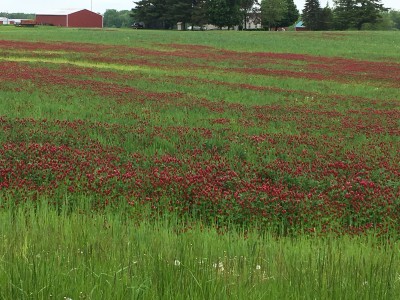Reducing the Risk of Compaction When Grazing Cover Crops
Nancy Glazier, Small Farms & Livestock Specialist
Northwest New York Dairy, Livestock & Field Crops

The benefits of cover crops have been known for many years; one is remediating compaction. Cover is critical for soil health, reducing erosion, and scavenging nutrients. What about adding livestock? The first hurdle is fencing and water. Temporary or semi-permanent fencing can be set up relatively easily and taken down to get out of the way of equipment. Water demand will be less with cooler temperatures and the remainder needed can be hauled. Adding cover crop grazing can give permanent pastures a longer rest period before the next grazing season or help with that summer slump.
The predominant concern of grazing cover crops is soil compaction. A recent report from Practical Farmers of Iowa was published highlighting a four-year study looking at this issue. Two farm locations were used, both with conventional cash crops that partnered with nearby livestock farmers. The control was no cover crops and no livestock, the treatment was cover crops that were grazed. On both farms compaction was significantly less with cover crops and grazing treatment. The grazing periods were short for both fall and spring. Possibly a truer comparison would be to add a third scenario of cover crops with no grazing. Planning can work through a lot of the issues. Fall precipitation can make the process even more challenging.
Some points to ponder:
- Remember the three - grasses, legumes, and forbs (broadleaves). Ideally, more than one of each type is in the mix.
- Allow adequate growth of at least 8" prior to grazing. This is two-fold - provides adequate forage plus sufficient root mass for cushioning.
- The motto, "take half, leave half" still applies. Leave at least 4-5" of residual.
- Ideally, graze when ground is frozen or dry. Livestock will need to be moved to another area (sacrifice area, barnyard, etc.) with rain events over 0.5", unless ample plant cover is there (over 2 tons DM/acre). Be aware of sorghums, sudan, and millets with frost and prussic acid. Some of these annuals may be frostkilled by the time you read this.
- Cover crops are highly digestible; you may need to add some dry hay to slow digestion down. The right mix may balance fiber and protein.
- Bloat may be a concern with winter wheat. Feed dry hay prior to putting livestock out for the first time.
- If possible, move the livestock to a new paddock every one - two days. This helps reduce the risk of compaction while more evenly dispersing manure and urine.
The key to success is adaptation. A different type of grazing plan is needed for cover crop grazing. This would not have worked last year as it was too darn wet. Another challenge we face is we have less frozen ground through winter months. Livestock may do a great job of reducing heavy spring biomass if cover crops have grown too much. Let me know if you have any questions, or would like to show me you've made it work.
Additional resources to accompany Nancy Glazier's November 2019 Ag Focus article "Reducing the Risk of Compaction When Grazing Cover Crops."
Grazing Cover Crops: A How To Guide - http://pastureproject.org/wp-content/uploads/2018/12/Grazing_Cover_Crops_How_To_Guide_FINAL.pdf
Grazing Cover Crops to Avoid Soil Compaction - https://www.iowalearningfarms.org/files/page/files/Cover%20Crops%20and%20Soil%20Compaction.pdf
Soil Compaction in Grazed Cover Crop Fields - https://practicalfarmers.org/research/soil-compaction-in-grazed-cover-crop-fields/
Upcoming Events
Crops, Cows & Critters - Southwest New York Dairy, Livestock & Field Crops Newsletter Sponsorship
December 19, 2025
Our two forms of publications feature research-based and timely information from our four specialists, listed to the right, along with local event notifications and Cornell University outreach. This information is provided to participants who range from dairy, livestock, and field crops producers to agricultural suppliers and consultants.
Weekly Email Update: Shared with 625+ households who have signed up with our program.
Monthly Paper Mailer: To reach our stakeholders and farmers who lack internet access, we send out a monthly mailer where your company's logo and contact information would be featured with a mailing list of 330+ households.
If you sponsor our weekly and monthly publications you reach approximately 955 households.
Visit our website to view our newsletters!
2025 Cornell Food Beverage & Animal Feed Manufacturer Survey
December 19, 2025
Industry and Educational Advocates for New York State's Food, Beverage, and Animal Feed Manufacturing industries:
As you know, NYS has a diverse food and beverage manufacturing industry, in both the types of industries that exist and the wide distribution of firms by scale. Many manufacturing firms have strong backward linkages to agricultural production sectors in the state that support both farm-level and downstream food industry firms and consumers. In collaboration with the New York State Department of Agriculture and Markets, a team from Cornell University's Charles H. Dyson School of Applied Economics and Management has recently rolled out the 2025 New York State Food, Beverage, and Animal Feed Manufacturer Survey. The industry will benefit from an updated assessment of the industry that informs private and public investments and opportunities to support firm growth and improved profitability.
Cornell Organic Field Crops & Dairy Conference
March 6, 2026
Waterloo, NY
Farmers, researchers, educators, and agricultural service providers from across the Northeast are invited to the 2026 Cornell Organic Field Crops & Dairy Conference, held Friday, March 6, 2026, from 8:00 a.m. to 4:30 p.m. at the Lux Hotel & Conference Center in Waterloo, N.Y.
Co-hosted by New York Soil Health and Cornell CALS, the annual conference brings together leaders in organic grain, dairy, and livestock systems to share practical tools, new research, and farmer-tested strategies to support resilient and profitable organic production.
Announcements
No announcements at this time.





